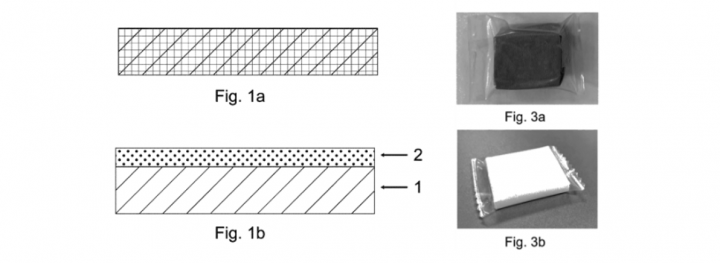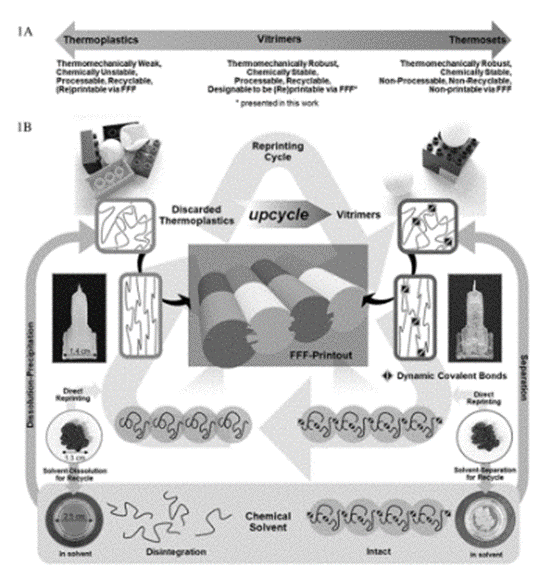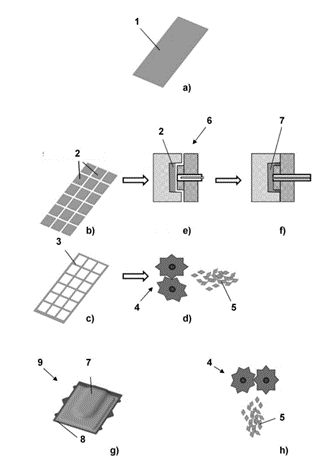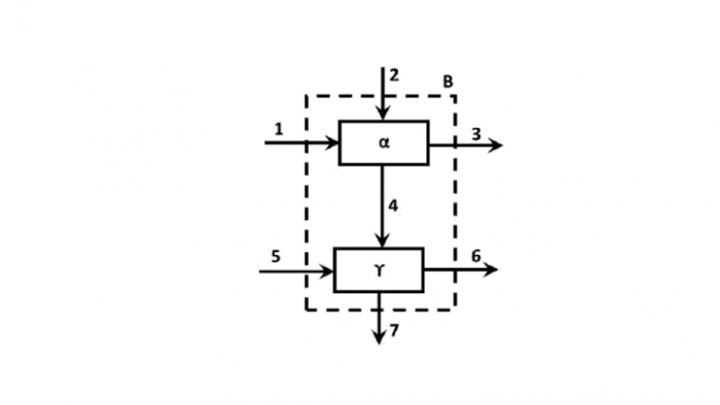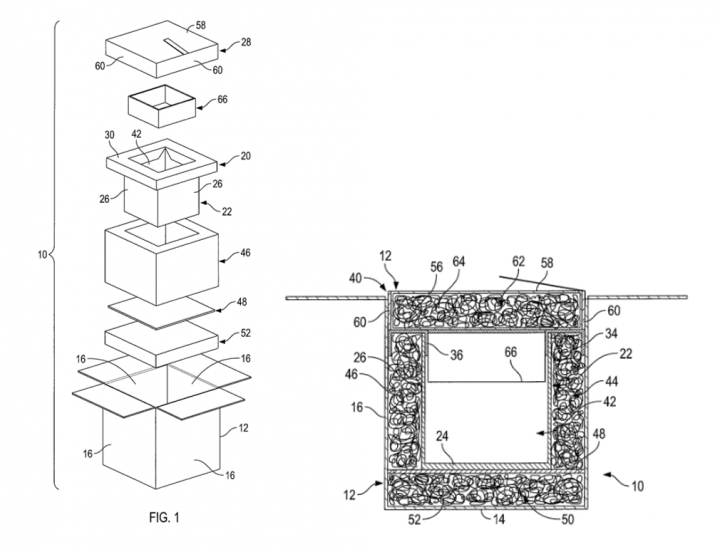Covering the topic of circular textiles and plastics, the patent selection of this month starts with textiles and plastics obtained from renewable sources. Examples of methods for processing these renewable plastics and textiles into building blocks, namely their monomers via depolymerization, for further polymers synthesis and processing into new products. At the product design phase, product circularity must be considered for example, by designing and manufacturing the products in the way that these can be dismantled or fully recycled (design for dismantling, design for recycling) like in examples of patents included in this selection. Finally, this selection includes an invention addressing the challenge of recovering both elastane and nylon from fabric waste to be reused as input materials in manufacturing.
Design and production of sustainable and biodegradable woven fabric with renewable PLA (polylactic acid) fiber
Patent number: WO2023/282865
Publication date: 2023-01-12
Applicant(s): MENDERES TEKSTIL SAN VE TIC A S
Inventor(s): KAYMAKCI SERDAR; ALSAN SERKAN; ERTUNA SÜLEYMAN İLKER; İPEK FATMA; GÖDE CEREN; GÜNGÖR YUSUF
Motivation
PLA is a polymer from the group of aliphatic polyesters synthesized from alpha- hydroxy acids. Known to be environmentally friendly, PLA is synthesized by condensation polymerization of lactic acid obtained from renewable resources (corn, wheat, rice...). It is a biocompatible and recyclable polymer. It has better thermal processability compared to most biopolymers including poly(hydroxy alkanoate) (PHA), poly(ethylene glycol) (PEG), and poly(s- caprolactone) (PCL). Lactic acid polymers can be processed by a variety of methods since they show thermoplastic behavior. Fiber drawing, extrusion, and molding are the most common ones among these methods.
Summary
The invention relates to a method for obtaining environmentally-friendly, sustainable, and biodegradable yarns by subjecting the PLA (polylactic acid), which is used in many different sectors such as the food packaging industry, health and medical industry, construction industry, cosmetic industry, and textile industry, to a variety of procedure steps with the open-end method, and a new fabric to be used in the textile sector thanks to the weaving of the said yarns in the following steps:
- Blowroom System: PLA is blended in this system. A metal remover helps remove the metal if any. Dust and dirt are removed, PLA is turned into fiber and arrives at the carding system. The blowroom system includes a combination of stages until carding. This system provides a coarse cleaning of the PLA.
- Carding Machine: Fibers cleaned and disentangled. PLA moved by air from the blowroom system is fed from the chute feed into the taker-in at a fixed amount. The taker-in feeds these fibers to the cylinder since they rotate in the same direction and the cylinder rotates faster. It also removes 70-75% of noil and foreign particles arriving at the card. Carding procedure is performed between the cylinder and the flats which becomes possible thanks to the opposing directions of clothing wires, the same direction of rotation, and the higher peripheral speed of the cylinder compared to the peripheral speed of the doffer. Carded fiber arrives at the doffer. Accumulation takes place thanks to the opposing directions of wires, the same direction of rotation, and the higher peripheral speed of the cylinder compared to the peripheral speed of the doffer. The fiber is removed from the doffer with the stripping system. In the delivery funnel and calender rollers, the web is collected through the web funnel in the calender rollers and made into a round sliver.
- Drawing Frame: Sliver irregularity is reduced by way of doubling and drafting. Different slivers are blended by doubling. Unlike the first passage drawing frames, the second passage drawing frames consist of a regulation apparatus. Since this is the last machine before the open- end structure, the whole sliver is aimed to be homogenized here. Working Principle of Regulation Apparatus: The thickness of slivers is measured by two rollers prior to their entry to the drafting zone. Feeding is increased or decreased in the case of thinner or thicker slivers. If the material is thick, then the back rollers are slowed down and the material is fed slowly, or the front rollers are accelerated so that this thick part is ensured to be properly drawn.
- Open-end Yarn Machine: The slivers coming out of the drawing frame are fed into the cans and these cans are later taken to the open-end machine to be processed. Fibers subjected to the opening procedure are in the form of individual fibers. Then, a portion of fiber mass is fed into the rotor and pulled toward the edges by the impact of centrifugal forces; fibers are twisted via yarn-end between twist funnel and rotor wall. Yarn formation is thus achieved.
Plant protein-starch films
Patent number: WO2023079115
Publication date: 2023-05-11
Applicant(s): XAMPLA LTD
Inventor(s): BARROUX HUGO THOMAS; GKOTSIS GEORGIOS; RODRIGUEZ GARCIA DR MARC; KEEN POLLY HELENA RUTH; AIKEN JAMES ALEXANDER; SOMMERVILLE-ROBERTS NIGEL PATRICK
Motivation
There is an increasingly urgent need to reduce the environmental impact of many day-to-day activities and to reduce the amounts of non-renewable resources involved in these activities. An example of this is the increasing use of biodegradable packaging to replace conventional plastics such as polyethylene and polypropylene (e.g. edible films for use in packaging of foodstuffs). Starches are especially useful materials due to their renewable source and low cost. A particular problem for starch-based films is that starch is sensitive to low temperatures due to retrogradation. Packaging of foodstuffs can often be subjected to low temperatures when the packaged foodstuff is stored in a fridge. This has meant that it has not been possible to develop commercial films containing significant amounts of starch that are robust enough to withstand all of the conditions that may be required for foodstuff packaging. However, the low cost and ready availability of starch means that it is still a desirable material to incorporate into such films.
Summary
The present invention describes films that are both robust and dispersible in water. The films of the present invention are therefore useful as packaging materials as they have the strength to withstand a manufacturing process and subsequent transportation and storage, but can then disperse upon contact with water, e.g. to release the product that has been packaged. Thus, the present invention provides a film comprising greater than or equal to 50 wt% of a combination of a plant protein and starch based upon the total weight of the film at 55% relative humidity and 22 °CC, wherein the weight ratio of starch to plant protein is in the range 0.5:1 to 30:1, and wherein the plant protein has been pre-treated with an organic acid. Preferred films of the present invention are monolayer films. An example of such a film is depicted graphically in Figure 1a. Alternative preferred films of the present invention are multilayer films. Thus, a preferred film of the present invention comprises: a first layer comprising starch; and a second layer comprising a plant protein, wherein the plant protein has been pre-treated with an organic acid; wherein the second layer is in contact with a first surface of the first layer; wherein the film comprises greater than or equal to 50 wt% of a combination of a plant protein and starch based upon the total weight of the film at 55% relative humidity and 22 °C; and the weight ratio of starch to plant protein is in the range 0.5:1 to 30:1. An example of such a multilayer film is depicted graphically in Figure 1b, wherein layer (1) is the first layer and layer (2) is the second layer.
Crosslinked polymeric composition and its use in additive manufacturing
Patent number: US20230147086
Publication date: 2023-05-11
Applicant(s): UT BATTELLE LLC
Inventor(s): SAITO TOMONORI; KIM SUNGJIN; RAHMAN MD ANISUR
Motivation
Plastics production (currently >400 Mt/year) and incineration are estimated to account for 16% of the global net carbon emission by 2050, which is a significant surge from 2.3% in 2013. Integrative interventions, including increasing the plastics recycling rate and reducing the production demand growth, were simulated to reduce carbon dioxide (CO2) emissions by 93% in the best-case scenario. Thus, establishing a closed loop system for plastics' usage is crucial for achieving net-zero carbon emission. For example, recycling polydiketoenamines with a circular design was reported to emit only 1/43 of CO2 compared with producing virgin resins without circularity. However, the recycling rate of traditional plastics remains low because of the deteriorating properties of plastics upon recycling, as well as added costs.
Summary
The present disclosure is directed to upcycling of unsaturated thermoplastics, such as acrylonitrile butadiene styrene (ABS), into a recyclable and robust dynamic covalent network (ABS-vitrimer), which is advantageously useful as a feedstock material in FFF. The vitrimer exhibits mechanical robustness and chemical resistance by virtue of its covalent network formation, but it can also be malleable by reconfiguring reversible crosslinks through dynamic bond exchange at elevated temperature, making it recyclable. The associative bond exchange between the vitrimer layers upon printing improves the weak inter-filament bonding and solvent resistance of the FFF-printed structures. The FFF of upcycled ABS-vitrimers fulfills the intertwined thermomechanical-chemical-environmental needs for circular plastics manufacturing. The full FFF-processing of ABS-vitrimer overcomes the major challenge of (re)printing crosslinked materials and produces stronger, tougher, solvent-resistant 3D objects directly reprintable and separatable from unsorted plastic waste. The process is not only effective in recycling of unsaturated thermoplastics, such as ABS, but advantageously modifies the recycled thermoplastic to have the properties of a crosslinked thermoset, yet is completely extrudable and printable by virtue of the dynamic covalent crosslinks present after modification of the recycled thermoplastic by the present process.
Method for the depolymerization of a poly(alpha-hydroxy acid)
Patent number: EP4293008
Publication date: 2023-12-20
Applicant(s): UNIVERSITÄT HAMBURG
Inventor(s): ENTHALER STEPHAN
Motivation
In a primary depolymerization step, the End-of-Life -PLA is converted into suitable monomers that can be used in the second part, polymerization, to generate new PLA. In contrast to other established recycling methods, such as mechanical recycling and downcycling, the properties of the chemically recycled polymer are not linked to the quality of the EoL plastic, i.e., the quality can be adapted to requirements in each cycle. In the case of chemical recycling of EoL-PLA, for example, there are several prior art approaches for depolymerization (e.g., hydrolysis, glycolysis, methanolysis). Hydrolysis is considered to be advantageous, since lactic acid is obtained as a depolymerization product, which serves as the starting material for industrial PLA syntheses. However, in the prior art methods using hydrolysis of poly(lactic acid), long reaction times are required or PLA oligomers or short-chain PLAs are mainly obtained. There is still a need for methods that make recycling of poly(α-hydroxy acid) plastics, in particular PLA, more efficient.
Summary
The invention relates to a method for the depolymerization of a poly(α-hydroxy acid), for example a poly(lactic acid). The method comprises the steps of: (1) contacting the poly(α-hydroxy acid) with water; and (2) heating the mixture of the poly(α-hydroxy acid) and water in the presence of a catalyst suitable for catalyzing the depolymerization of the poly(α-hydroxy acid). The method of the invention provides a method with the help of which poly(α-hydroxy acid) plastics (PHA plastics), for example poly(lactide) plastics, PLA, can efficiently be depolymerized, for example to enable a chemical recycling of the polymer. It has surprisingly been found that PHA plastics like PLA, for example, can efficiently be hydrolyzed in the presence of a suitable catalyst. In contrast to known chemical depolymerization methods, the catalyzed hydrolytic depolymerization according to the invention does not require any additional solvents. Rather, water is used as the sole reactant and solvent. The method of the invention involves comparatively short reaction times, i.e., reaction times ≤ 1 hour. In addition, the method of the invention has a high tolerance towards contaminants (e.g., dyes, adhesives, biological contaminants, paper) and towards the presence of other plastics and can thus also be used with impure, e.g., unsorted, incorrectly or badly sorted, plastic fractions. PHA plastics can selectively be converted to their respective monomers, PLA to lactic acid, for example, with the method of the invention, enabling chemical sorting/separation in case of plastic mixtures.
Method for producing sandwich components from a plate-shaped sandwich semi-finished product
Patent number: WO2023/066800
Publication date: 2023-04-20
Applicant(s): FRAUNHOFER-GESELLSCHAFT ZUR FÖRDERUNG DER ANGEWANDTEN FORSCHUNG EINGETRAGENER VEREIN
Inventor(s): GLÄSSER THOMAS; MICHEL PETER; STACHE PETER
Motivation
Sandwich construction based on endless fiber-reinforced plastics is one of the most efficient lightweight construction technologies to produce large-area structural components. There is a need for production methods enabling full recycling of component at the end of life.
Summary
The invention is based on the object of producing fiber-reinforced sandwich components provided with at least one functional component, preferably for lightweight applications, in a manner which is intended to enable the sandwich component, after its intended use or use, to be subjected to material recycling over its entire circumference, i.e. without loss of material. The aim is to realize the sandwich component in the form of a recyclate which is as pure as possible to create the prerequisite for closed material circulation. In addition, the method should be usable in industrial large-scale production to be able to produce pure sandwich components in large numbers at competitive unit costs.
Process for the recovery of spandex and nylon from spandex and nylon comprising materials
Patent number: EP4306586
Publication date: 2024-01-17
Applicant(s): CAP III B.V.
Inventor(s): VERDUYCKT JASPER; MARKUSSE ABRAHAM PETER; CUIPER ANNA DITE; TINGE JOHAN THOMAS
Motivation
In 1959, the American textile chemist Joseph Shivers invented spandex fibers, also known as Lycra or elastane. The synthesis of spandex consists of an initial step of reacting a macroglycol with a diisocyanate monomer to give a prepolymer. A typical ratio of glycol to diisocyanate is 1:2. Spandex fibers are known for their exceptional elasticity: they can be stretched to almost 500% of their length and thereafter can recover to its original shape. Generally, spandex is not used on its own, but it is mostly mixed with other natural fibers, like cotton, and/or man-made fibers, like nylon 6 and polyethylene terephthalate (PET). Thus, spandex usually accounts for only a small percentage of the final fabric, which therefore retains most of the look and feel of the other fibers. Examples of clothes containing fabric blends of nylon 6 and spandex include stretchable stockings, underwear, and sportswear. Recycling of nylon 6 enables the conservation of fossil resources and can add value to the circular economy. Depolymerization recycling processes for nylon 6 are well developed for clean and rather pure wasted nylon 6 materials. Up to now no process exists for the recovery of both nylon 6 and spandex from nylon 6 and spandex comprising materials on an industrial scale. There is a need for processes that allow the recovery of nylon 6 and spandex from nylon 6 and spandex comprising materials on an industrial scale in order to process the huge amounts of nylon 6 and spandex comprising materials that are wasted annually
Summary
The present invention provides a process for recovering nylon and spandex from nylon and spandex comprising material in a plant, wherein the plant comprises: a separation section [B], which comprises a dissolution section [α], and a precipitation section [γ] and wherein the process comprises the steps of: (1) charging an organic solvent, and the nylon and spandex comprising material to the dissolution section [α]; (2) selective dissolution of the spandex from the nylon and spandex comprising material in the organic solvent in the dissolution section [α], preferably at a temperature ranging from 0 °C to 100 °C, more preferably at a temperature ranging from 10 °C to 90 °C, even more preferably at a temperature ranging from 10 °C to 80 °C and most preferably at a temperature ranging from 20 °C to 75 °C, so that a spandex rich stream comprising organic solvent and dissolved spandex and a stream comprising non-dissolved nylon are obtained; (3) discharging the obtained spandex rich stream from the dissolution section [α]; (4) charging a second solvent and the spandex rich stream to the precipitation section [γ] so that spandex is precipitated from a mixture comprising organic solvent and the second solvent; (5) recovering said precipitated spandex from said mixture comprising organic solvent and second solvent and discharging said precipitated spandex from the precipitation section [γ], wherein the spandex content of the discharged stream is at least 85 % by weight on dry-weight basis, more preferably at least 90 % by weight on dry-weight basis; (6) discharging the mixture comprising organic solvent and second solvent from which precipitated spandex has been recovered in step (5) from the precipitation section [γ]; and (7) discharging the stream comprising non-dissolved nylon obtained in step (2) from dissolution section [α].
A recyclable thermoplastic composition
Patent number: WO2023/067236
Publication date: 2023-04-27
Applicant(s): UPM-KYMMENE CORPORATION
Inventor(s): GALL BARBARA; DIEHL FLORIAN
Motivation
In the light of sustainability and circular economy it is desired to recycle thermoplastic compositions or materials, such as packaging materials, in a closed loop. Carbon black is commonly used as the pigment or filler in black colored plastics. Sustainability of the components of plastic production is of importance and there is a need for biobased and renewable components in the plastics. Therefore, the inventors have recognized a need for renewable black coloring fillers or pigments, which allow sorting of the polymers in the composition and thus enable recycling of the thermoplastic composition.
Summary
A recyclable thermoplastic composition made by using at least one polymer and a lignin-based filler is disclosed. The lignin-based filler may be prepared from lignin subjected to hydrothermal carbonization treatment. The lignin-based filler may comprise carbon in a total amount of 62 - 70 weight-% and ash in a total amount of at most 3 weight-%, and the color of the thermoplastic composition may be represented by an L value of at most 25, an A value of at most 8, and a B value of at most 12 as determined by DIN EN I SO 11664. Further is disclosed the use of a lignin based filler, wherein the lignin-based filler is prepared from lignin subjected to hydrothermal carbonization treatment, and wherein the lignin-based filler comprises carbon in a total amount of 62 - 70 weight-% and ash in a total amount of at most 3 weight-%, for producing a recyclable thermoplastic composition by using at least one polymer and the lignin-based filler, wherein: the color of the thermoplastic composition is represented by an L value of at most 25 , an a value of at most 8 , and a b value of at most 12 as determined by DIN EN I SO 11664.
Recyclable, thermally insulated shipping container with packed, loose-fill organic insulation and phase change material (PCM) bladder insert
Patent number: US20230251011
Publication date: 2023-08-10
Applicant(s): PACKAGING TECHNOLOGY GROUP, LLC
Inventor(s): BLEZARD WILLIAM C; LAWLOR THOMAS; PHALEN KYLE
Motivation
In many applications, an insulated shipper comprises a cardboard outer box, insulating material, such as a plurality of expanded polystyrene (EPS) panels or pieces of insulation, and phase change material (PCM) gel packs, bricks, etc. used to heat or cool the interior of the shipper. While the prior art shipping containers are effective for their intended purpose, the combined use of both cardboard and inorganic insulation, i.e. EPS and/or other plastic materials, in a single packaging system poses problems for recycling of the container in traditional recycling programs as the different materials must be separated for recycling of each material, or cannot be recycled at all, requiring dumping into a landfill. Due to increasing demands from environmentally conscious businesses, customers and the general public, there is a growing need to utilize shipping and packing containers which are fully recyclable without separation of any component parts.
Summary
The present disclosure provides a unique all organic fiber recyclable, thermally insulated shipping container which can be placed directly into the recycling stream without separation of the insulating materials and may be recycled in a such a way that wood fiber materials are re-pulpable and capable of being converted into other paper-based products. A recyclable, thermally insulated shipping container in accordance with the teachings of the present invention is entirely constructed from organic fiber materials (container and insulation) in such a manner that the container is curbside recyclable without any separation of component materials. The container may include a corrugated cardboard outer box having a bottom wall, a plurality of sidewalls and a top wall, a corrugated cardboard inner liner assembly including a corrugated cardboard inner box having a bottom wall and a plurality of sidewalls, and a corrugated cardboard lid assembly. In some embodiments, the sidewalls of the liner assembly may comprise paper materials. The outer box is conventional in construction formed from a box blank secured in a square or rectangular shape along a side wall edge, with top and bottom closure flaps to create a traditional six-sided box. The inner box is similarly conventional box construction forming a square or rectangular five-sided open top box with bottom closure flaps forming a bottom wall. The inner liner assembly may further consist of a corrugated cardboard or paperboard liner flange having a continuous top shelf portion, a plurality of outer securing tabs projecting downwardly from an outer peripheral edge of the top shelf portion, and a plurality of inner securing tabs projecting downwardly from an inner peripheral edge of the top shelf portion.





